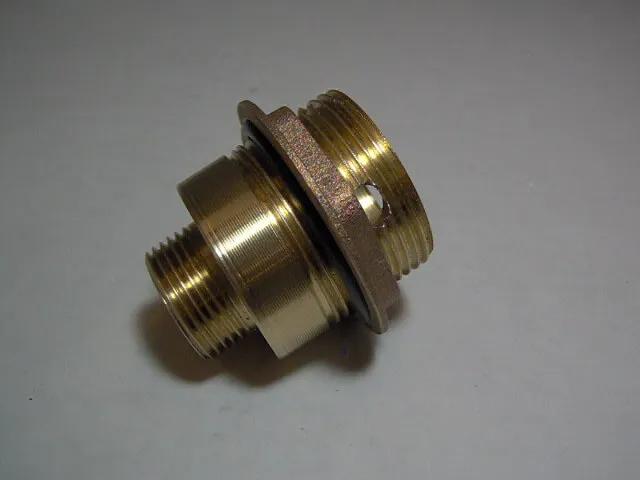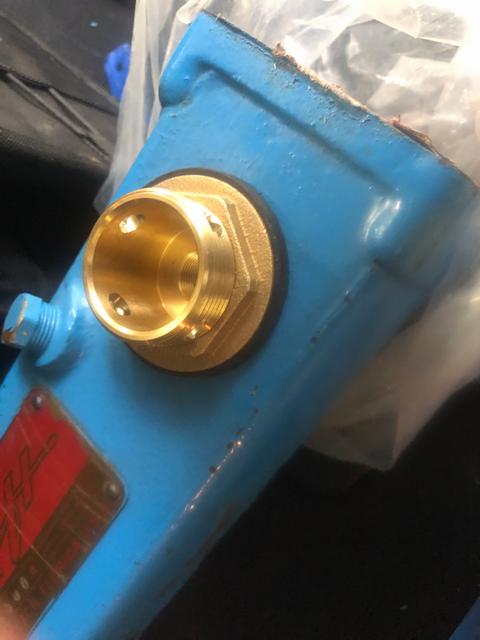EXTERIOR:
Hull: The top exterior side planks adjacent to gunwales have been replaced completely from prow to transom. They were fashioned from Okumi 7 ply 1/2 inch marine mahogany plywood, finger-jointed, and installed as one piece. The hull has been refastened completely. The copper rivets were drilled out between ribs and refastened with marine grade (MG) stainless steel screws bedded with West System two part epoxy. All fairing was completed using West System two part epoxy mixed with West 410 filler powder. Planks are true and smooth as they have never been refinished using a rotary disk type sander. The front deck, rear deck, hardtop and interior sole, as well as seats were all removed to facilitate cleaning and treating the interior of the hull. The interior of the hull was then painted using original Chris Craft grey bilge paint.
FRONT DECK: the front deck was completely replaced. Deck cross supports were strengthened by increasing material width from 3/4 to l 1/4 inch Honduras mahogany, bolted to the outer plates instead of screwed. An additional cross member was added. The deck was then sheeted again using 1/2 inch Okumi ply. All fasteners were of MG SS quality. The deck was then over laid with nautilex deck material (white with black rib design). The interior finish of deck was stained brown mahogany, multicoated with varnish.
The portion of the deck showing inside the hardtop was inlaid with solid mahogany, stained and varnished.
HARDTOP: I previously had replaced the overhang boards and chines of the hardtop with new mahogany, which mains in excellent condition. The top was sheeted with Okumi 1/4 in ply, fastened to the white oak cross ribs using copper ring nails. The interior surface is stained and varnished with the ribs painted white. The outside surface of top is covered with one piece R.V. roof bladder in white. This was used instead of cabin topping to eliminate a center seam in the hardtop exterior.
The gas tank has been removed and sent out for professional cleaning and then was reinstalled.
BACK DECK; The cross rib, face plate, and upright supports were replaced with new mahogany increasing the stock width of the supports, pieces being finished with stain and varnished. The deck was sheeted with half inch Okumi mahogany ply. It was then inlaid with solid mahogany bedded with West System two part epoxy. It was then stained and varnished to match the dash.
INTERIOR: The interior floor (sole) was totally replaced both top and bottom sides having been painted and the top of floor covered with nautilex (white with black rib design). Two below floor lockers were created outside of the engine stringers and aft of the engine compartment.
The engine box was replaced, stained and varnished as well as being sound insulated. The interior sides of hull were redesigned and recovered. The port side seat was moved aft to provide the construction of a dinette with table and a rear facing seat which is also a locker. The table drops to provide a roomy single berth on deck. The side windows at the windshield that were fixed were converted to functional no-draft vents.
BINNACLE: The binnacle has been added to left and right to provide for the installation of a depth sounder, additional switches, and a SUMLOG gauge. Also a pod was installed directly below the binnacle at the bullhead for installation of the V.H.F. radio and stereo. All additions were fashioned from mahogany and finished to match the binnacle.
MECHANICAL: The original engine has been replaced with a 350 c.i. 4 bolt block and has been balanced to reduce vibration. The original heads were rebuilt and retained to maintain fuel economy. The horsepower output has increased from 185 h.p to 280 h.p. The carburetor and alternator are original, however rebuilt. The fuel pump is new and an additional canister type fuel filter is installed. Use of non leaded fuel is compatible with this engine. The prop shaft was replaced with a stainless steel shaft, and the seal at the transmission thrust bearing has been replaced. The transmission is a Paragon reverse gear type with a 1 1/2 to 1 reduction. The steering mechanism and cable have been replaced. The electrical wiring has been replaced and a new independent circuit fuse panel installed.
[2024 Roseman note. I have added:
- Marine grade Holley carb (600 CFM, Model 4160, 0-80319-2)
- marine grade Holley mechanical fuel pump (110 GPH Mechanical Fuel Pump -Marine Part# 712-327-11
- Parker water separator/filter model 110A with R11T Fuel Filter/Water Separator Replacement Element
- 6AN (3/8") stainless covered fuel lines.
2025-08-21
I was not happy with the starting and reliability with the new carb, and decided to switch to electronic fuel injection and electronic ignition. I was lucky to have expert advice from Donavan Lattimore, of Lattimore Racing Engines. He has great experience and expertise with Holley Sniper EFIs and the Holley electronic ignition system. Purists may be offended, but automobiles have switched to EFI decades ago, and there is no doubt in my mind that Chris Craft would have used this technology had it been avaiable
A new Edelbrock intake manifoil was powder-coated by Mike Wilson, Mi-DiPowder Coating of Shelby, MI [1] A Holley Sniper Electronic Fuel Injection unit was installed on the manifold. [manual] There were several challenges:
- The EFI requires a fuel return line to the gas tank. I tapped the side of a piece of 2" stainless steel pipe for a 3/8 NPT compression fitting. I was told that the return needed to be below the fuel level, ao this was accomplished with 3/8" stainless tubing and additional compression fittings. The drilling and tapping was done on a Bridgeport mill, and would have been easier with carbide tools.
- The EFI requires an oxygen sensor in the exhaust. The problem is that cooling water is mixed with the exhaust, and water kills the sensor. I found an adapter from Howell EFI
Installation required machining a 1" hole in the water jacket of the starboard exhaust manifold, and a 3/4" NPT thread in the inner exhaust. This was skillfully done by Bill Dodds at Peacock Industries of Baldwind, Michigan The chosen location was opposite to the number 7 (foreward-most) exhaust port, to keep it as far away as possible from the water entrance.

- A high-pressure electric fuel pump (58 psi) was required, with a 10 micron pre-filter, 10 Micron post filter, and pressure regulator. The pre filter was part of a Parker Racor 110A water separator/filter. These were mounted on a Varithaned 1" x 6" piece of white oak, installed under the aft seat.
Electronic ignition
The major advantage of adding this is that it is controlled by the computer that is integral to the Sniper EFI. It includes a new distributer, control box and coil. The original distributer was located at the aft end of the engine. Donavan chose to remove the tachometer sending unit at the forward end of the engine, and place the new distribuor there. Top dead ceter (TDC) was located for the #1 cylinder, and the spark plug wires inserted in the order 1-8-4-3-6-5-7-2. The old distributer was left in place, with no connections, at least for now.
Holley part numbers
Alternator
After installing the EFI, we found that the alternator had failed. The original was a Prestolite with the markings "ALE 5202 70" This was replaced with another Prestolite, almost identical to the original.
[More to come. Any questions, call 231.873.7176 or DLR@eolas.com].
End of DLR comments
HULL VENTILLATION: I decided to modify the air ventilation below the interior floor due to l\VO problems I encountered during many years of operation of this boat. The first problem resulted from the on deck air intake vents situated amidships. The vents were mounted flush with the deck and allowed rain water to enter the bilge area. Due to the hull being of a Iapstrake plank design, this water flowed forward and aft along the interior plank joints. Over a period of time, dirt carried in with the water would build up between the planks and the inner ribs creating a condition conducive to the development of dry rot. Secondly, the air was exhausted by means of two clam shell vents installed atop the rear deck inboard from the gunwales on each side of the boat. Due to very little air movement in the underside outer corners of the rear deck, dry rot developed in the rear upper corners of the rear deck. The dry rot was restricted to the underside of the deck and did not affect the adjacent areas of the transom or side planks. To solve this problem, the flush deck vents were eliminated along with the back clam shells. Louvered side vents were installed in the top plank on each side of the hull adjacent to the transom and high up on the planks. Air flow now originates through vents in the front deck and exits at the top outer corners at the transom, The bilge blower is also plumbed to exhaust through the starboard rear louvered vent.
INCLUDED EQUIPMENT: Original 4 1/2 Inch illuminated Danforth compass - rebuilt to new condition. Original Lovett bilge pump AM 340421 Hom sea ladder
ADDITIONAL EQUIPMENT
- Bennett trim tabs VDO Sum log sender/0-270-273 readout/0-402-345
- Life ring and throw line with custom mount
- Bilge blower
- Shore power with breaker panel and three outlets
- Halon fire control system - active- 2 heads- 1 over engine- 1 over fuel tank
- Newmar marine 15 amp automatic battery charger - 2 bank capacity
- Fire extinguisher -general model C-TCP-51 Type ABC
- Mariner 7800 VHF ship to shore radio
- Maxima AM-FM cassette radio with 4 built in speakers
- Ray Jeff depth sounder
- Anchors-2 Danforth and 20 LB. lunch book
- Ships bell custom cast brass -6 inch
- Auxiliary Bilge pump- Located aft
- Teak Swim Platform c/w ladder -
Not installed- Search Light